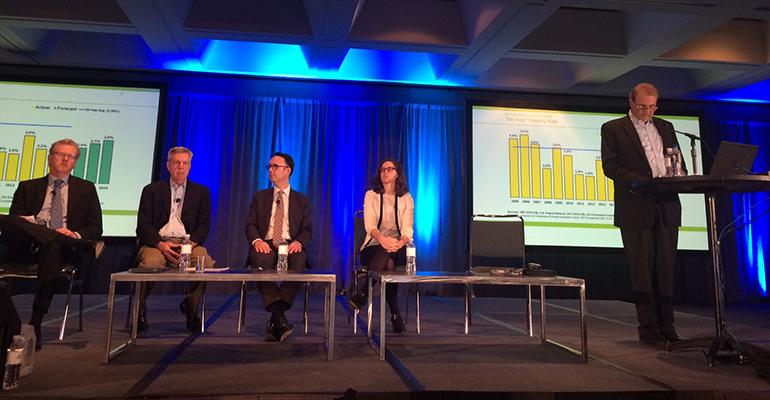During Wednesday’s sessions at the Urban Land Institute’s 2017 Fall Meeting taking place in Los Angeles, panelists focused on the real estate forecast for the next three years and the creation of vibrant city centers. Here are 10 takeaways from Wednesday’s panels:
- Based on ULI’s forecast of stable GDP growth in the 2 percent range and low unemployment from now until 2019, real estate investors who are waiting for a drop in asset prices will continue to wait, noted Melissa Reagen, managing director and head of America’s real estate research with real estate investment management firm TH Real Estate and one of the panelists participating in the “Learning in Real Time: Experts Share Their Forecasts for Real Estate in ’17, ’18 and ‘19” discussion. “If you were waiting for property prices to fall, you might be disappointed,” she said.
- While the panelists conceded it’s time for comprehensive tax reform, they remain apprehensive about what version of reform will pass, given the current lack of detail. “If we have deep tax cuts [in today’s business climate], it will give us inflation and higher interest rates, and will lead to a recession two or three years down the road,” noted Ken Rosen, chairman of the Fisher Center for Real Estate and Urban Economics at UC Berkeley. According to Hans Nordby, managing director with research firm CoStar Portfolio Strategy, tax reform could be a boon for the commercial real estate sector, but it can just as easily end up being “stupid and weird tax reform.”
- The current Administration’s plan to cut legal immigration also worries the panelists, since legal immigration drives U.S. population growth to a significant extent and will impact most real estate sectors. “If there’s a change to immigration policy, it’s going to change the whole market,” said Reagen.
- Industrial warehouses will continue to be the best-performing core asset class over the next two years, due to strong demand from e-commerce players and a dearth of new supply. “We think it’s the best risk-adjusted return right now,” noted William Maher, director for North America research and strategy with LaSalle Investment Management.
- Meanwhile, approximately 40 percent of U.S. retail centers will become obsolete, according to Nordby, with the only hope for the properties being eventual conversion to another asset type.”I think a decade from now, [the retail sector] will look totally different than it does today,” said Reagen. “I do think the next five to 10 years look really rough.”
- While there may be attractive investment opportunities in suburban office, Lee Menifee, managing director and head of Americas investment research with investment firm PGIM Real Estate, cautioned potential buyers to be aware of capital expenditures required to lure tenants to those types of assets. PGIM found that those requirements put significant downward pressure on returns and “we don’t see them going down anytime soon.”
- When it comes to the multifamily sector, luxury apartment projects may not be penciling out as well as they did a few years ago, but workforce housing, or class-B and class-C multifamily stock, will continue to be resilient, according to Nordby. One of the reasons is that the renters most likely to move on to homeownership are those that can afford the class-A rents. “People who live in workforce housing, unfortunately are never going to buy a house,” Nordby noted.
- According to a study completed by ULI Europe and EY that will be released this November, demand for co-working space will triple over the next five years, revealed Lisette van Doorn, CEO of ULI Europe and one of the panelists on “The Future of Business Districts.”
- One of the overarching themes at this year’s fall conference has been the need to create more affordable housing in cities across the United States. To that end, Jonathan F.P. Rose, president of development and investment firm Jonathan Rose Cos. and one of the speakers at the “Getting Cities Right” media lunch, noted that “the costs of construction or acquisition of affordable housing today [makes it so it] simply can’t be done without subsidies.” But “we also have to think of completely non-governmental solutions.”
- Rose also noted that the world may be at a point when its cities have lost sense of how to maximize their resources. “When that happens, [historically] there’s collapse and the collapse is usually violent.” To counterbalance these forces, cities need to come up with solutions to income inequality and create a sense of social cohesion. “These are the key links of getting us to the future,” Rose said.
0 comments
Hide comments

